 W
WThe Battle of Bakenlaagte occurred on 30 October 1901 during the guerrilla phase of Anglo-Boer war of 1899–1902. The battle saw the Eastern Transvaal Boer commandos of Generals Grobler, Brits, Viljoen and Louis Botha attack the rear guard of Colonel Benson's much feared No. 3 Flying Column while it was in marching formation to its base camp.
 W
WThe Battle of Belmont was an engagement of the Second Boer War on 23 November 1899, where the British under Lord Methuen assaulted a Boer position on Belmont kopje.
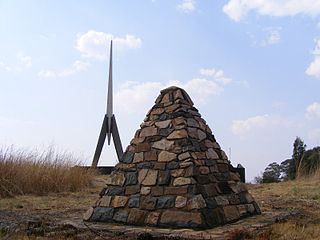 W
WThe Battle of Berg-en-dal took place in South Africa during the Second Anglo-Boer War.
 W
WThe Battle of Boshof was a battle fought during the Second Boer War on 5 April 1900 between British forces and mostly French volunteers of the Boer army.
 W
WLake Chrissie is a lake in Msukaligwa Local Municipality, Mpumalanga, South Africa. It is a shallow and large lake, with a maximum depth of about 6 metres (20 ft), 9 kilometres (5.6 mi) long, 3 kilometres (1.9 mi) wide. The lake is named after Christiana Pretorius, daughter of Marthinus Wessel Pretorius, first president of the boer Transvaal Republic. The lake is also informally known as "Matotoland" and its swazi name is "Kachibibi".
 W
WThe Battle of Colenso was the third and final battle fought during the Black Week of the Second Boer War. It was fought between British and Boer forces from the independent South African Republic and Orange Free State in and around Colenso, Natal, South Africa on 15 December 1899.
 W
WThe Battle of Diamond Hill (Donkerhoek) was an engagement of the Second Boer War that took place on 11 and 12 June 1900 in central Transvaal.
 W
WThe Battle of Driefontein on 10 March 1900 followed on the Battle of Poplar Grove in the Second Boer War between the British Empire and the Boer republics, in what is now South Africa. In the first half of 1900, the British made an offensive towards the two Boer republic capitals of Bloemfontein and Pretoria. The Boer forces under the command of Christiaan de Wet were holding a 7-mile (11 km) line covering the approach to Bloemfontein. Lord Roberts subsequently ordered a division under Lieutenant General Thomas Kelly-Kenny to attack the position from the front, while Lieutenant General Charles Tucker's division moved against its left flank. The Boers were subsequently forced to withdraw losing 124 men killed and captured, while the British lost 82 killed and 342 wounded.
 W
WThe Battle of Elands River was an engagement of the Second Boer War that took place between 4 and 16 August 1900 in western Transvaal. The battle was fought at Brakfontein Drift near the Elands River between a force of 2,000 to 3,000 Boers and a garrison of 500 Australian, Rhodesian, Canadian and British soldiers, which was stationed there to protect a British supply dump that had been established along the route between Mafeking and Pretoria. The Boer force, which consisted of several commandos under the overall leadership of Koos de la Rey, was in desperate need of provisions after earlier fighting had cut it off from its support base. As a result, it was decided to attack the garrison along the Elands River in an effort to capture the supplies located there.
 W
WThe Battle of Elands River took place near the Elands River Poort mountain pass on 17 September 1901 during the Second Boer War. During the battle a Boer raiding force under Jan Smuts destroyed a British cavalry squadron led by Captain Sandeman, a cousin of Winston Churchill, on the Modderfontein farm. This battle is therefore also known as the Battle of Modderfontein.
 W
WThe Battle of Elandslaagte was a battle of the Second Boer War, and one of the few clear-cut tactical victories won by the British during the conflict. However, the British force retreated afterwards, throwing away their advantage.
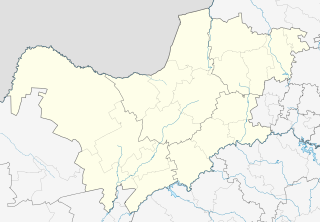 W
WHartbeesfontein is a settlement near Klerksdorp, in the North West province of South Africa. It is situated at the intersection of the R503 and R507 routes.
 W
WThe siege of Kimberley took place during the Second Boer War at Kimberley, Cape Colony, when Boer forces from the Orange Free State and the Transvaal besieged the diamond mining town. The Boers moved quickly to try to capture the area when war broke out between the British and the two Boer republics in October 1899. The town was ill-prepared, but the defenders organised an energetic and effective improvised defence that was able to prevent it from being taken.
 W
WThe Battle of Kraaipan was the first engagement of the Second Anglo-Boer War, fought at Kraaipan, South Africa on 12 October 1899.
 W
WWhen the Second Boer War broke out on 11 October 1899, the Boers had a numeric superiority within Southern Africa. They quickly invaded the British territory and laid siege to Ladysmith, Kimberley and Mafeking. Britain meanwhile transported thousands of troops both from the United Kingdom itself and from elsewhere in the Empire and by the time the siege of Ladysmith had been lifted, had a huge numeric superiority.
 W
WThe siege of Ladysmith was a protracted engagement in the Second Boer War, taking place between 2 November 1899 and 28 February 1900 at Ladysmith, Natal, a township founded in 1850.
 W
WThe Battle of Leliefontein was an engagement between British-Canadian and Boer forces during the Second Boer War on 7 November 1900, at the Komati River 30 kilometres (19 mi) south of Belfast at the present day Nooitgedacht Dam. During the engagement, the Canadian rearguard successfully repelled Boer assaults against the column, facilitating the successful withdrawal of the British-Canadian force from the area.
 W
WThe siege of Mafeking was a 217-day siege battle for the town of Mafeking in South Africa during the Second Boer War from October 1899 to May 1900. The siege received considerable attention as Lord Edward Cecil, the son of the British prime minister, was in the besieged town, as also was Lady Sarah Wilson, a daughter of the Duke of Marlborough and aunt of Winston Churchill. The siege turned the British commander, Colonel Robert Baden-Powell, into a national hero. The Relief of Mafeking, while of little military significance, was a morale boost for the struggling British.
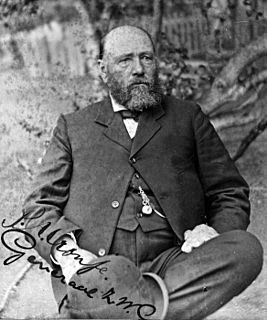 W
WThe Battle of Magersfontein was fought on 11 December 1899, at Magersfontein, near Kimberley, South Africa, on the borders of the Cape Colony and the independent republic of the Orange Free State. British forces under Lieutenant General Lord Methuen were advancing north along the railway line from the Cape to relieve the siege of Kimberley, but their path was blocked at Magersfontein by a Boer force that was entrenched in the surrounding hills. The British had already fought a series of battles with the Boers, most recently at Modder River, where the advance was temporarily halted.
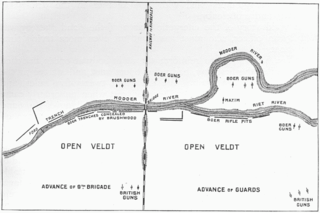 W
WThe Battle of Modder River was an engagement in the Boer War, fought at Modder River, on 28 November 1899. A British column under Lord Methuen, that was attempting to relieve the besieged town of Kimberley, forced Boers under General Piet Cronjé to retreat to Magersfontein, but suffered heavy casualties altogether.
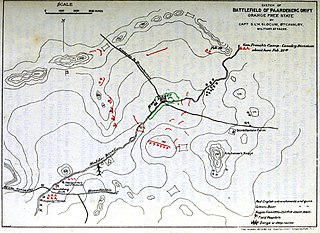 W
WThe Battle of Paardeberg or Perdeberg was a major battle during the Second Anglo-Boer War. It was fought near Paardeberg Drift on the banks of the Modder River in the Orange Free State near Kimberley.
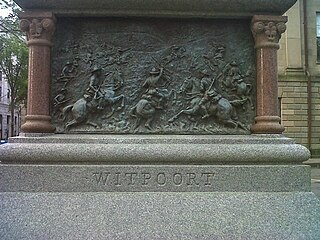 W
WThe Battle of Witpoort was a battle during the Second Anglo-Boer War. Major Frederick Henry Munn commanded the detachment of the Royal Irish Fusiliers at Witpoort which was attacked on 16 July 1900, his orders being to "hold his position at all costs". The Boers called on Major Munn to surrender, but, scornfully refusing, he held out from daybreak till 2 pm, when the Canadian forces mounted a counterattack and the Boers retired. The battle became famous because of the death of Harold Lothrop Borden.
 W
WThe Battle of Tugela Heights, consisted of a series of military actions lasting from 14 February through to 27 February 1900 in which General Sir Redvers Buller's British army forced Louis Botha's Boer army to lift the Siege of Ladysmith during the Second Boer War.
 W
WThe Battle of Poplar Grove was an incident on 7 March 1900 during the Second Boer War in South Africa. It followed on from the Relief of Kimberley as the British Army moved to take the Boer capital of Bloemfontein. The Boers were demoralised following the surrender of Piet Cronjé at the Battle of Paardeberg. General Sir John French's cavalry attacked the Boer force from the rear while mounted infantry and horse artillery attacked from the right flank. The Boers abandoned their positions in panic before the cavalry. The commander-in-chief of the Free State forces, Christiaan de Wet, in his book called the chapter on the subject "Wild Flight from Poplar Grove".
 W
WThe Battle of Spion Kop was a military engagement between British forces and two Boer Republics—the South African Republic and the Orange Free State—during the campaign by the British to relieve the besieged city Ladysmith during the initial months of the Second Boer War. The battle was fought 23–24 January 1900 on the hilltop of Spion Kop(1), about 38 km (24 mi) west-southwest of Ladysmith.
 W
WThe Battle of Stormberg was the first British defeat of Black Week, in which three successive British forces were defeated by Boer irregulars in the Second Boer War.
 W
WThe Battle of Talana Hill, also known as the Battle of Glencoe, was the first major clash of the Second Boer War. A frontal attack by British infantry supported by artillery drove Boers from a hilltop position, but the British suffered heavy casualties in the process, including their commanding general Sir William Penn Symons.
 W
WThe Battle of Tugela Heights, consisted of a series of military actions lasting from 14 February through to 27 February 1900 in which General Sir Redvers Buller's British army forced Louis Botha's Boer army to lift the Siege of Ladysmith during the Second Boer War.
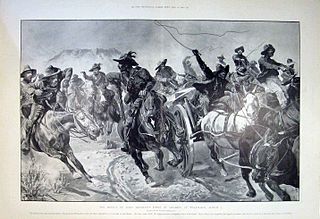 W
WIn the Battle of Tweebosch or De Klipdrift on 7 March 1902, a Boer commando led by Koos de la Rey defeated a British column under the command of Lieutenant General Lord Methuen during the final months of the Second Boer War.
 W
WThe Battle of Vaal Krantz was the third failed attempt by General Redvers Buller's British army to fight its way past Louis Botha's army of Boer irregulars and lift the Siege of Ladysmith. The battle occurred during the Second Boer War.